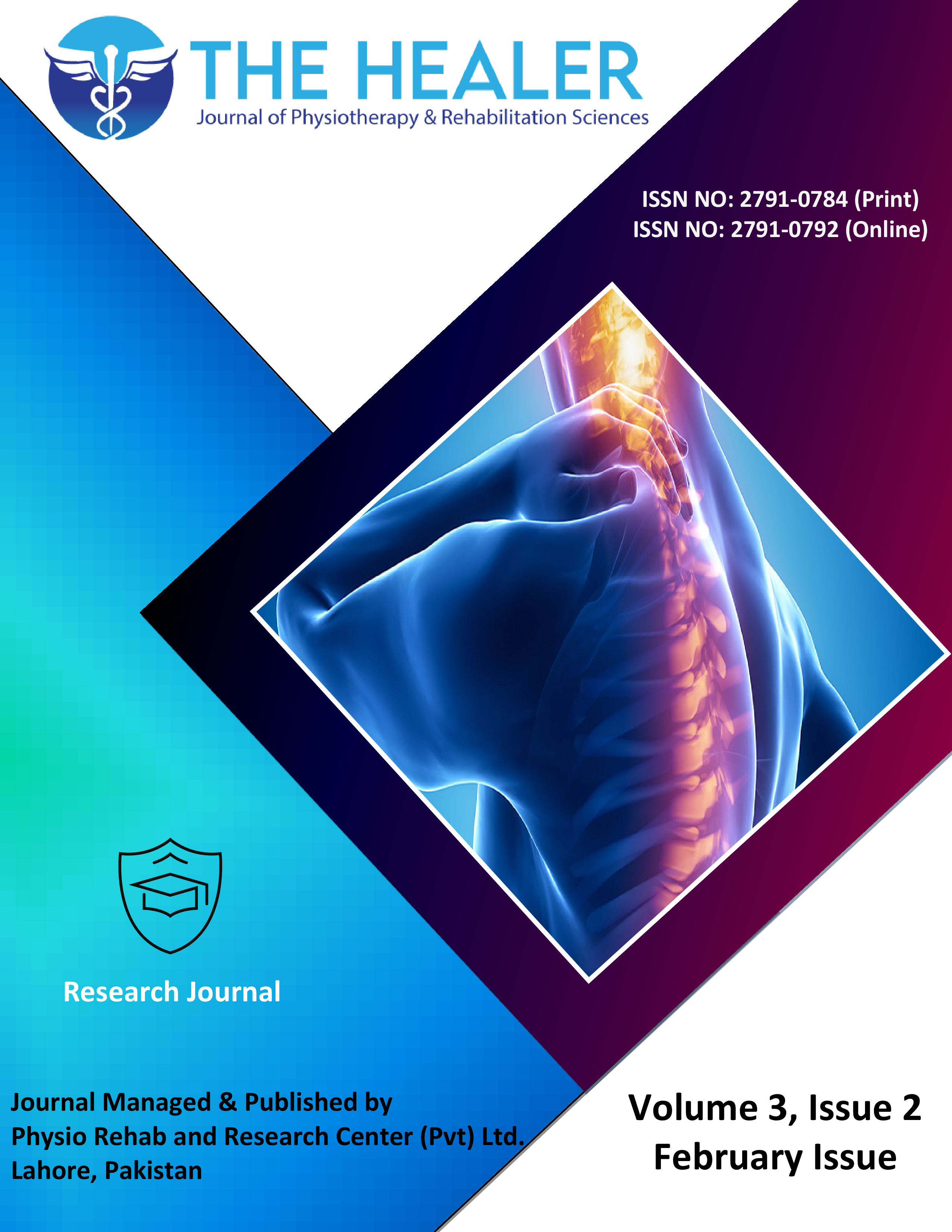Prevalence of Cervical Radiculopathy Among Teachers
Cervical Radiculopathy Among Teachers
DOI:
https://doi.org/10.55735/hjprs.v3i2.132Keywords:
Cervical radiculopathy, prevalence, teachers, nerve root compressionAbstract
Background: Pinched nerves or cervical radiculopathy, are caused by damage to the nerves or changes in the way they function. A nerve root close to the cervical vertebrae is compressed, causing the pain. Objective: To determine the frequency of cervical radiculopathy among teachers and to find out the difference in the prevalence of cervical radiculopathy concerning demographics. Methods: The population of this cross-sectional study was male and female teachers from different institutes of Faisalabad using convenient sampling in their offices for five months. Participants aged from 25 to 70 years having teaching experience of a minimum of 2 years and daily teaching service of more than 6 hours were included in the study. Patients with some psychological problems, a history of systemic diseases or any serious illnesses were eliminated from the study. Informed consent was taken from the participants who ensured their willingness to participate in the study. Written instructions were provided to them regarding responding to the instrument. After the administration of these questionnaires final size of the sample was male teachers Questionnaires were distributed to teachers to fill in the required data. The participants signed the written consent willingly and all data was kept confidential. Only those regions were assessed that were relevant to this study. The categorical variables were evaluated by frequency and percentages, while the mean and standard deviation were calculated by continuous variables. Results: It highlights the prevalence of cervical radiculopathy among male and female teachers separately with male teachers experiencing more symptoms than female teachers. It showed a strong connection between the height of the chair, table, whiteboard, lifestyle, age and cervical radiculopathy. It suggested that teachers must have an active lifestyle to not be the victim of cervical radiculopathy. Conclusion: Male teachers scored high on cervical radiculopathy as compared to females. It was also found that teachers with more age scored higher on cervical radiculopathy. Furthermore, teachers who were using chairs and tables of height less than 20 inches scored more on cervical radiculopathy. Moreover, teachers who were using a whiteboard with less height also scored higher on cervical radiculopathy.
References
Woods BI, Hilibrand AS. Cervical radiculopathy. Journal of Spinal Disorders and Techniques 2015; 28(5): E251-E9.
Eubanks JD. Cervical radiculopathy: nonoperative management of neck pain and radicular symptoms. American family physician 2010; 81(1): 33-40.
Afzal M, Khan S, Tariq S, Tariq Z, Sohail S, Rehman M. Effects of sustained natural apophyseal glides combined with transcutaneous electrical nerve stimulation in cervical radiculopathy. Journal of Bashir Institute of Health Sciences 2022; 3(1).
Carette S, Fehlings MG. Cervical radiculopathy. New England Journal of Medicine 2005; 353(4): 392-9.
Parkinson J. An essay on the shaking palsy. The Journal of neuropsychiatry and clinical neurosciences 2002; 14(2): 223-36.
Salemi G, Savettieri G, Meneghini F, et al. Prevalence of cervical spondylotic radiculopathy: a door‐to‐door survey in a Sicilian municipality. Acta Neurologica Scandinavica 1996; 93(2‐3): 184-8.
Radhakrishnan K, Litchy WJ, O'fallon WM, Kurland LT. Epidemiology of cervical radiculopathy: a population-based study from Rochester, Minnesota, 1976 through 1990. Brain 1994; 117(2): 325-35.
Khedr EM, Fawi G, Abbas MA-A, et al. Prevalence of neuromuscular disorders in Qena governorate/Egypt: population-based survey. Neurological Research 2016; 38(12): 1056-63.
St-Pierre GH, Thomas K. Radiculopathy and Myelopathy at Segments Adjacent to the Site of a Previous Anterior Cervical Arthrodesis. 50 Landmark Papers: CRC Press; 2018: 113-6.
Mostofi K, Khouzani RK. Reliability of cervical radiculopathy, its congruence between patient history and medical imaging evidence of disc herniation and its role in surgical decision. European Journal of Orthopaedic Surgery & Traumatology 2016; 26: 805-8.
Alare K, Omoniyo T, Adekanle T. Postural Predisposition to Cervical Spondylosis Among Housewives, Teachers, Computers and Smart Phones Users. International Journal of Neurologic Physical Therapy 2021; 7(2): 14.
Hattrup SJ, Cofield RH. Rotator cuff tears with cervical radiculopathy. Journal of shoulder and elbow surgery 2010; 19(6): 937-43.
Iyer S, Kim HJ. Cervical radiculopathy. Current reviews in musculoskeletal medicine 2016; 9: 272-80.
Tong HC, Haig AJ, Yamakawa K. The Spurling test and cervical radiculopathy. Spine 2002; 27(2): 156-9.
Date ES, Rappaport M, Ortega HR. Dermatomal somatosensory evoked potentials in brachial plexus injuries. Clinical Electroencephalography 1991; 22(4): 236-49.
Kosek E, Lampa J, Nisell R. Smärta och inflammation: vid reumatiska sjukdomar och vanliga smärttillstånd i rörelseapparaten: Studentlitteratur; 2019.
Luo TD, Levy ML, Li Z. Brachial Plexus Injuries. StatPearls [Internet]: StatPearls Publishing; 2021.
Mwangi A, Downing R, Elias HE. Low back pain among primary school teachers in Rural Kenya: Prevalence and contributing factors. African Journal of Primary Health care and family medicine 2019; 11(1): 1-7.
Converso D, Viotti S, Sottimano I, Cascio V, Guidetti G. Musculoskeletal disorders among preschool teachers: analyzing the relationships among relational demands, work meaning, and intention to leave the job. BMC Musculoskeletal Disorders 2018; 19(1): 1-8.
Abdulmonem A, Hanan A, Elaf A, Haneen T, Jenan A. The prevalence of musculoskeletal pain & its associated factors among female Saudi school teachers. Pakistan journal of medical sciences 2014; 30(6): 1191.
Yue P, Liu F, Li L. Neck/shoulder pain and low back pain among school teachers in China, prevalence and risk factors. BMC public health 2012; 12(1): 1-8.
Engquist M, Löfgren H, Öberg B, et al. Surgery versus nonsurgical treatment of cervical radiculopathy: a prospective, randomized study comparing surgery plus physiotherapy with physiotherapy alone with a 2-year follow-up. LWW; 2013.
Cohen SP. Epidemiology, diagnosis, and treatment of neck pain. Mayo Clinic Proceedings; 2015: Elsevier; 2015. p. 284-99.
Eggers L. Prevalence and selected risk factors for neck, shoulder and low back pain among primary school teachers in the Central Durban area: A cross-sectional study; 2016.
Zamri E, Moy F, Hoe V. Association of psychological distress and work psychosocial factors with self-reported musculoskeletal pain among secondary school teachers in Malaysia. PloS one 2017; 12(2): e0172195.
Chiu TT, Lam PK. The prevalence of and risk factors for neck pain and upper limb pain among secondary school teachers in Hong Kong. Journal of occupational rehabilitation 2007; 17: 19-32.

Downloads
Published
How to Cite
License
Copyright (c) 2023 The Healer Journal of Physiotherapy and Rehabilitation Sciences

This work is licensed under a Creative Commons Attribution 4.0 International License.
CC BY












